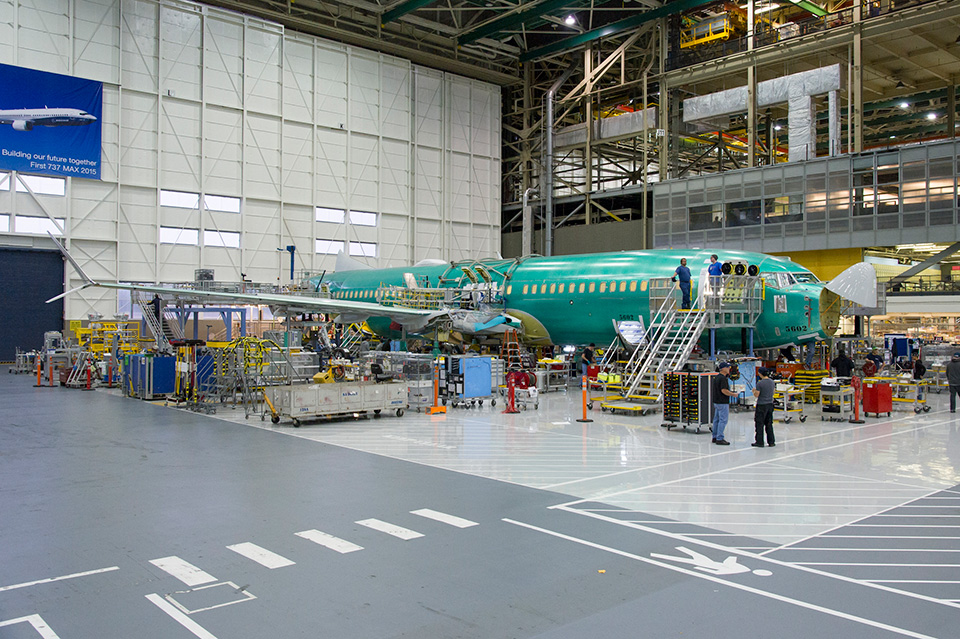Leeham News and Analysis
There's more to real news than a news release.
Bjorn’s Corner: Engine efficiency
 18 September 2015, ©. Leeham Co: The debate around the market’s two single aisle combatants is quite heated, with fans of the one side saying “the limited space for a high bypass engine on the 737 MAX will cripple it forever” and the other side saying “the tighter design of the 737 will make it highly competitive against the A320neo, it is the A320 which has a weight and size problem”.
18 September 2015, ©. Leeham Co: The debate around the market’s two single aisle combatants is quite heated, with fans of the one side saying “the limited space for a high bypass engine on the 737 MAX will cripple it forever” and the other side saying “the tighter design of the 737 will make it highly competitive against the A320neo, it is the A320 which has a weight and size problem”.
One of the arguments is that each inch of engine fan diameter brings 0.5% in increased propulsive efficiency. Therefore the A320 with up to 81 inches fans will win against the 737 MAX, which has a 69 inch fan. Having all the tools to check out if this is really the truth, I fed our airplane model with all the facts and looked at the result. It’s not so easy, guys…
A320 FAL “good for US aerospace,” says Airbus
Sept. 16, 2015, © Leeham Co., Mobile (AL): The opening of the Airbus A320 Final Assembly Line here achieves a major set of goals set by the company 10 years ago for its own strategic purposes, but officials are also mindful of the larger impact on US aerospace.
achieves a major set of goals set by the company 10 years ago for its own strategic purposes, but officials are also mindful of the larger impact on US aerospace.

David L. Williams, VP Procurement, Airbus Americas. Photo via Google images.
Top executives point out that the Mobile plant reestablished a second commercial aviation assembly site in the US since the last MD-11s and MD-95s rolled out of the former McDonnell Douglas plant in Long Beach (CA) after its acquisition by The Boeing Co in 1997. Boeing continued production of the MD-11 until the end of 2000 (with deliveries occurring in 1Q2001). The last MD-95, renamed the Boeing 717, was produced in 2006. There were 200 MD-11s and 156 717s produced.
With nearly 10 years elapsing between that last 717 and the first A321ceo coming out of Mobile, Airbus officials say the creation of the FAL is not only good for Airbus and Alabama, it’s good for US aerospace.
Rolls-Royce and Safran, major European engine OEMs with different fortunes.
By Bjorn Fehrm
Subscription required.
July 30, 2015 © Leeham Co. Rolls-Royce and Safran, the parent company of CFM partner Snecma, released their Q2 and first half 2015 earnings today. It is interesting to compare these companies as they are in different strategic situations in their dominant business segments, civil turbofan engines.
Civil turbofans constitute 52% of Rolls-Royce total business whereas it makes 54% of Safran’s turn over. Rolls-Royce’s focus has been widebody engines to the point where it exited its part of International Aero Engines, which makes the single aisle V2500 engine, three years ago. Safran on the other hand is heavily invested in the single aisle market through its 50% part in CFM through its Snecma subsidiary.
The present situation and the future outlook for these two companies are intimately aligned with this strategic difference. We look at why and how this will affect their immediate future.
Summary:
- Rolls-Royce is experiencing migration problems in its widebody turbofan business. Its bread and butter Trent 700 engine is on its way out and it takes until 2018 for the replacement, Trent 7000, to kick in.
- Other programs are only growing slowly: the Trent 1000 for Boeing’s 787 or Trent XWB for the Airbus A350.
- Safran civil turbofan business Snecma is enjoying record sales and deliveries through its CFM joint venture with GE.
- Despite sharing its revenue 50:50 with GE, the business turnover is the size of Rolls-Royce turbofan business today and larger tomorrow. Profit margins are three times higher.
Bjorn’s Corner: hot summer, hot engines
17 July 2015, ©. Leeham Co: It is summer in south of Europe and we have had over 30°C/86°F for weeks. It makes one realize the conditions where the engines have to work over their flat rating point in the Middle East.
Aircraft engines are a bit fidgety. They don’t like temperature although they are made to sustain that their hottest parts, the nozzle and first turbine after the combustor, gets scalded to 1700°C/3,092°F or more.
Go down to the very back end of the engine and we come to where the key engine parameter, EGT (Exhaust Gas Temperature), is measured. It determines a lot of things, among them the time the engine stays on wing. Things are typically 700°C/1,832°F cooler here and this is where a reliable temperature measurement probe can be placed. Based on its values, the total health of the engine’s core is determined. It is also a key input whether the engine shall be throttled back in a hot take-off like in the Middle East.
LEAP, the best of 1,000 investigated alternatives.
By Bjorn Fehrm
Subscription required.
Introduction
June 23, 2015, © Leeham Co. CFM International went through 1,000 iterations before settling on the final design for the LEAP engines that will power the Airbus A320neo, the Boeing 737 MAX and the COMAC C919.
In an interview with us at the Paris Air Show, CFM LEAP program manager Gareth Richards explained the macro process of the development of LEAP, CFM’s sequel to CFM56. This will be the largest turbofan engine program in the history of civil aviation and the follow on to the world’s most-sold turbofan, the CFM56.
Richards focused on how an engine like LEAP gets designed and what the trades are that a single aisle, short haul engine has compared to long haul engines.
LEAP is sharing the A320neo platform with Pratt & Whitney’s GTF but is sole engine on the 737 MAX and the C919. This will lead to engine production rates five years into the program of 1800 engines which is higher than the present rate of CFM56 deliveries.
Dependant on rate increases by Airbus and Boeing, this can increase beyond 2,000 engines per year after the initial ramp. It would make LEAP the largest civil turbofan program whichever way one counts: engines, installed thrust or revenue.
Summary:
- Research of optimal engine cycle was extensive, with more than 1,000 alternatives investigated before settling on the final LEAP cycle.
- The production ramp is the fastest ever, from 30 engines 2015 to 1,700 by 2019.
- While CFM does not want to ramp faster than planned, final production rate is flexible.
- The large volume of sold engines, the fast production ramp and the short-haul cycle makes for a conservative approach to performance.
- We discuss with Richards how such a program is managed and how you make sure you can deliver on promises.




 orders for the A320 and A350 production rates that have been announced. There’s pressure from the top commercial officer to hike rates, but the president and chief operating officer says not so fast.
orders for the A320 and A350 production rates that have been announced. There’s pressure from the top commercial officer to hike rates, but the president and chief operating officer says not so fast.
Airbus ‘confident’ engine makers can ramp up production
Subscription Required
Introduction
CFM makes about 50% of the engines on the A320 Family and has about 50% of the backlog for the New
Tom Enders, CEO of Airbus Group. Airbus photo.
Engine Option version. Pratt & Whitney has about the same market share for the NEO, depending on what month it is, with a large number of orders for which no engine has been selected.
Airbus and Boeing are each studying whether to ramp up production of the A320 and 737 families above the record rates already planned.
In an interview Sunday with Leeham News and Comment in advance of the A320 Final Assembly Line opening here, Enders said studies continue whether to take A320 production rates to 60 a month. Boeing is studying rates of 60-63 a month.
Summary
Read more
Leave a Comment
Posted on September 17, 2015 by Scott Hamilton
Airbus, Boeing, CFM, Leeham News and Comment, Pratt & Whitney, Premium
737 MAX, A320NEO, A380, A400M, air force tanker, Airbus, Airbus Group, Boeing, CFM, Fabrice Bregier, John Leahy, KC-46A, KC-X, Pratt & Whitney, SkyMark, Tom Enders, Transaero, USAF, Virgin Atlantic Airways